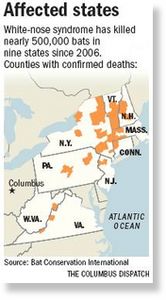
© Bat Conservation International/The Clumbus Dispatch
Thousands of caves and old mines in national forests, including the Wayne National Forest in Ohio, have been closed to people as the government tries to slow a mysterious disease that's wiping out bats.
Abandoned mines in the Wayne are well-known among biologists as winter havens for hibernating bats. Banning visitors could help keep white-nose syndrome from extending into Ohio, officials say. Discovered in New York in 2006, the disease has spread to eight other Eastern states, including Pennsylvania and West Virginia. The syndrome is named for a white fungus that grows on bats' faces, ears, wings and feet.
Nearly 500,000 bats have died.
Researchers are unsure whether the fungus is the disease or a symptom of it. They do know that it can kill 90 percent to 100 percent of bats hibernating in a cave.
"I can only assume that if it got here in Ohio it would be that bad," said Marne Titchenell, a wildlife program specialist with Ohio State University Extension. "It's extremely scary."
Bats are valued as the top predators of night-flying insects. One bat can devour 600 mosquitoes and moth-size insects in a night, Titchenell said.
The United States has 45 species of bats, and all are fragile. Bats that reach adulthood typically produce only two offspring during their average 10-year life spans, said Mitch Masters, an Ohio State University biologist.
If 90 percent of a colony was wiped out in a single winter, "it would take a long time to replace them," Masters said.
White-nose syndrome leaves bats severely underweight when they come out of hibernation. Many starve to death before the insects they eat emerge in the spring.
Researchers with the U.S. Fish and Wildlife Service say cavers might be spreading the disease by carrying fungal spores, which attach to their clothing, shoes and equipment.
Closing caves in national parks for a year could help slow or maybe stop the disease's progress, said Bill Bartush, the Forest Service's eastern region wildlife program manager.
"This is one way that we can at least buy some time and get some answers," Bartush said.
Bats that hibernate in Ohio caves and mines include the eastern pipistrelle, the little brown bat, the northern long-eared bat, the small-footed bat and the endangered Indiana bat.
There are 457,000 endangered Indiana bats in the United States, according to a 2005 U.S. Fish and Wildlife Service estimate. White-nose syndrome has killed nearly 25,000 Indiana bats.
The announcement is no surprise to cavers who have been closely tracking news about the disease, said Joe Gibson, chairman of the Central Ohio Grotto, a local chapter of the National Speleological Society.
He said that many caves he visits in Kentucky are now out of bounds.
"For the recreational caver, it's not going to be a good thing," Gibson said. "Whatever is recommended, we'll follow that, for the sake of the bats."

Reader Comments
to our Newsletter